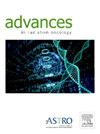基于深度学习的心腔分割在磁共振引导的适应性放射治疗中的应用
IF 2.7
Q3 ONCOLOGY
引用次数: 0
摘要
目的在磁共振(MR)引导的适应性放射治疗中,准确的心室分割对于提高心脏保存性至关重要,特别是对有辐射诱发心脏毒性风险的患者。在这里,我们开发并评估了使用在1.5 t MR- linac系统上获得的每日MR图像的心室自动分割模型。方法与材料20例健康志愿者每日在1.5 t MR- linac上进行2个径向序列磁共振扫描:T2/T1 3DVaneXD平衡快速场回波与光谱衰减反演恢复(bfe - spair)和T1 3DVaneXD mDixon。为每个序列测试三个翻转角度,以确定最佳的图像质量,用于腔室分割。全分辨率三维nnU-Net模型训练如下:(1)bFFE- spair (bFFE模型);(2) T1 mDixon (mDixon模型);(3)两个序列(混合模型)。基于Dice相似系数(DSC)和手工轮廓的平均表面距离对模型进行评估。临床对自动分割的接受程度用5分李克特量表进行评估。进行了一项计算机规划研究,以评估计划适应期间的心腔保留。结果bfe - spair的平均噪比分别为8.7(20°)、34.2(50°)和37.3(80°);对于T1 mDixon,这些值分别为3.6(5°)、5.9(10°)和4.9(20°)。bFFE模型的分割效果最好(平均DSC为0.85±0.05,平均表面距离为2.2±0.6 mm)。尽管T1 mDixon序列的对比噪声比较低,但其分割精度相似(DSC为0.83±0.06)。与bFFE模型相比,结合这两个序列的混合模型没有显著改善。临床评价表明,95%的bFFE模型的自动分割轮廓可用于临床(评分≥4)。适应性计划大大降低了个体心腔剂量,同时保持相似的靶覆盖率。结论本研究证明了利用bFFE-SPAIR和T1 mDixon序列在1.5 t MR-Linac上准确分割心室的可行性。这些模型为磁共振引导的适应性放射治疗中改善心脏保护提供了潜力。本文章由计算机程序翻译,如有差异,请以英文原文为准。
Deep Learning-Based Cardiac Chamber Segmentation in Magnetic Resonance-Guided Adaptive Radiation Therapy
Purpose
Accurate cardiac chamber segmentation is crucial for improving cardiac sparing in magnetic resonance (MR)-guided adaptive radiation therapy, especially in patients at risk for radiation-induced cardiotoxicity. Here, we developed and evaluated automatic segmentation models for cardiac chambers that use daily MR images acquired on a 1.5-T MR-Linac system.
Methods and Materials
Twenty healthy volunteers underwent daily MR scanning on a 1.5-T MR-Linac, with 2 radial sequences: T2/T1 3DVaneXD balanced fast field echo with spectral attenuated inversion recovery (bFFE-SPAIR) and T1 3DVaneXD mDixon. Three flip angles were tested for each sequence to determine optimal image quality for chamber segmentation. Full-resolution 3D nnU-Net models were trained for the following: (1) bFFE-SPAIR (bFFE model); (2) T1 mDixon (mDixon model); and (3) both sequences (hybrid model). Models were evaluated based on Dice similarity coefficient (DSC) and mean surface distance against manual contours. Clinical acceptance of the automatic segmentation was assessed with a 5-point Likert scale. An in-silico planning study was performed to assess cardiac chamber sparing during plan adaptation.
Results
The average contrast-to-noise ratios in bFFE-SPAIR were 8.7 (20°), 34.2 (50°), and 37.3 (80°); for T1 mDixon, these values were 3.6 (5°), 5.9 (10°), and 4.9 (20°). The bFFE model achieved the highest segmentation performance (average DSC 0.85 ± 0.05 and mean surface distance 2.2 ± 0.6 mm). The T1 mDixon sequence, despite lower contrast-to-noise ratios, provided similar segmentation accuracy (DSC 0.83 ± 0.06). A hybrid model combining both sequences showed no significant improvement over the bFFE model. Clinical evaluation indicated that 95% of the autosegmented contours from the bFFE model were acceptable for clinical use (score ≥4). Adaptive plan greatly reduced individual cardiac chamber dose while maintaining similar target coverage.
Conclusions
This study demonstrated the feasibility of using bFFE-SPAIR and T1 mDixon sequences to accurately segment cardiac chambers on a 1.5-T MR-Linac. These models offer potential for improved cardiac sparing in MR-guided adaptive radiation therapy.
求助全文
通过发布文献求助,成功后即可免费获取论文全文。
去求助
来源期刊

Advances in Radiation Oncology
Medicine-Radiology, Nuclear Medicine and Imaging
CiteScore
4.60
自引率
4.30%
发文量
208
审稿时长
98 days
期刊介绍:
The purpose of Advances is to provide information for clinicians who use radiation therapy by publishing: Clinical trial reports and reanalyses. Basic science original reports. Manuscripts examining health services research, comparative and cost effectiveness research, and systematic reviews. Case reports documenting unusual problems and solutions. High quality multi and single institutional series, as well as other novel retrospective hypothesis generating series. Timely critical reviews on important topics in radiation oncology, such as side effects. Articles reporting the natural history of disease and patterns of failure, particularly as they relate to treatment volume delineation. Articles on safety and quality in radiation therapy. Essays on clinical experience. Articles on practice transformation in radiation oncology, in particular: Aspects of health policy that may impact the future practice of radiation oncology. How information technology, such as data analytics and systems innovations, will change radiation oncology practice. Articles on imaging as they relate to radiation therapy treatment.
 求助内容:
求助内容: 应助结果提醒方式:
应助结果提醒方式:


